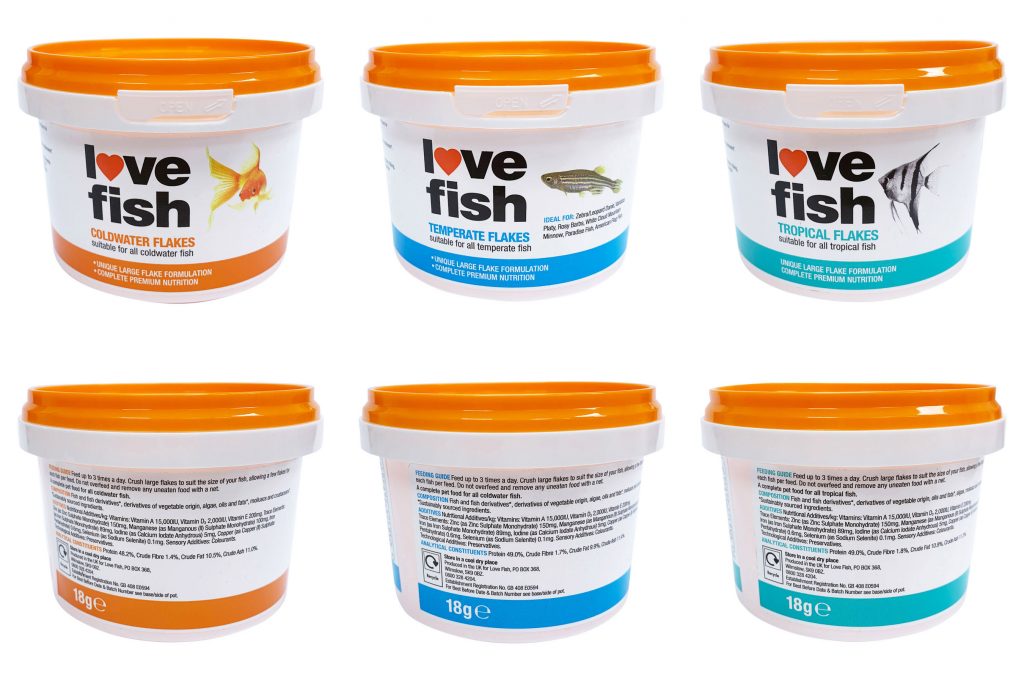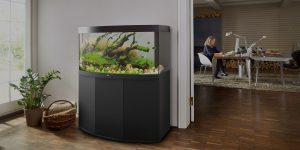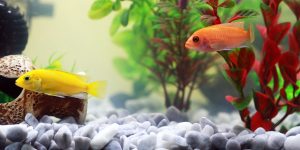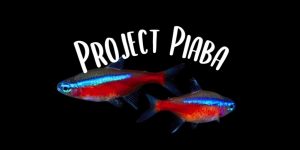At Your Aquarium, we don’t just offer fish tank maintenance, aquarium servicing, and a fish tank cleaning service, we also source incredible fish for our clients. Among the most popular right now are temperate species like glowlight danios, rainbow shiners, sparkled ricefish, and neon rosy barbs.
Temperate fish are great. Bridging the gap between cold water fish (most commonly goldfish) and tropical species, they offer the best of both worlds. Generally hardy and happy at room temperature like goldfish, most are also colourful like tropical fish. Moreover, they’re much smaller on average and far less messy than goldfish. And because they’re suited to room-temperature living, they don’t usually need an aquarium heater.
Are you already clued up on the ins and outs of temperate fish? Great! You may wish to jump straight to the temperate fish list. Alternatively, keep reading for a closer look at the meaning of the term temperate, temperate fish tank heating requirements (or the lack thereof!), and more.
Page contents
Did you know?
Did you know that a heater is often the costliest aspect of a tropical fish tank when it comes to energy usage and running costs? Because they don’t normally need a heater, temperate fish are, therefore, cheaper to keep!
Temperate fish meaning
In aquarium terms, temperate generally refers to fish happiest at a moderate level of warmth. That’s one that’s largely within the normal range that most people would consider “room temperature”. Temperate fish may also be called subtropical, which is, perhaps, a better, more apt, and easier-to-understand name!
Cambridge Dictionary describes temperate as “neither very hot nor very cold” – for example, a temperate climate. In terms of biology, they point toward temperate plants, which, like temperate fish, naturally thrive in places where the weather is moderate, temperature-wise, year-round.
Temperate fish temperature
Temperate fish are those that are happiest at temperatures between 18–23°C.
Some sources suggest that temperatures up to 25°C can be considered temperate. We’d argue that this is entirely wrong. At 25°C, water is well into tropical realms, and even in a warm home, in the UK, you would need a heater to maintain this temperature.
Temperate fish tank heating
Because temperate fish are happy at room temperature, they don’t generally need a heater when kept in a centrally heated home. As long as the temperature remains at 18°C or above, most will be fine without any supplementary heating.
In spaces where temperatures may drop below 18°C, it’s advisable to install a heater as a precaution. However, unlike tropical aquariums, where heaters are usually set at 24–26°C, in a temperate tank, you can program the heater to just 18°C – the lowest value on most models. As such, it’s probable that it’ll very rarely turn on, unless temperatures dip significantly or the tank is in a particularly cold room.
Heaters cost as little as £10. They only turn on when temperatures drop below the value set – in this case, 18°C. With that, there’s little need to worry about the cost of running the heater. That’s because, in most homes, it’ll seldom be on.
If you’re prone to worrying about the welfare of your fish and other pets, a heater is an affordable way to ensure peace of mind – even if it’s never actually needed!
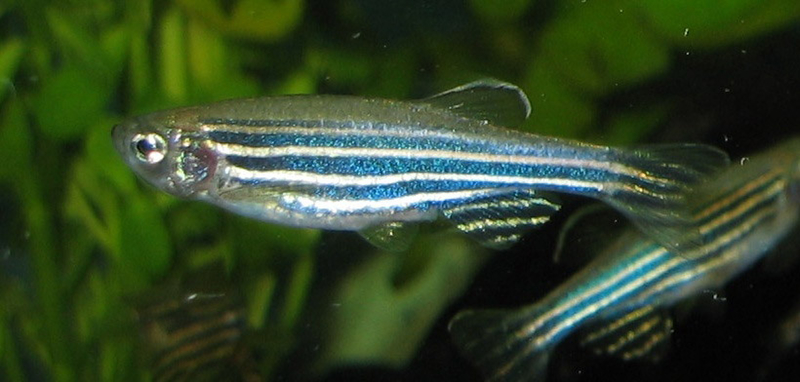
Temperate fish list
We’ve painstakingly put together a comprehensive list of over 50 temperate fish species. Most are readily available in the UK, although a few may require some shopping around to track down. Are you looking for something specific? Be sure to inspect our livestock sourcing options. Want to know more about a particular fish? If so, check out the care sheet links provided, each handpicked by us from the best on the web!
| Common name | Scientific name | Temp. range | Care Sheet |
|---|---|---|---|
| Albino paradise fish | Macropodus opercularis var. ‘Albino‘ | 18-23°C | |
| Armoured catfish | Callichthys callichthys | 18-28°C | |
| Asian moth catfish | Hara jerdoni | 18-24°C | |
| Black ruby barb | Pethia nigrofasciata | 18-26°C | |
| Black tiger badis | Dario sp. var. ‘Myanmar’ | 15-25°C | |
| Bloodfin tetra | Aphyocharax anisitsi | 18-28°C | |
| Buenos Aires tetra | Hyphessobrycon anisitsi | 15-27°C | |
| Butterfly goodeid | Ameca splendens | 15-30°C | |
| Clown catfish | Gagata cenia | 18-24°C | |
| Dwarf dragon goby | Rhinogobius duospilus | 15-25°C | |
| Dwarf snakehead | Channa gachua | 18-28°C | |
| Empire gudgeon | Eleotris compressus | 12-28°C | |
| Everglades pygmy sunfish | Elassoma evergladei | 10-30°C | |
| Florida flagfish | Jordanella floridae | 18-30°C | |
| Freshwater blenny | Salaria fluviatilis | 18-24°C | |
| Freshwater needlefish | Xenentodon cancila | 18-30°C | |
| Glowlight danio | Celestichthys choprae | 16-26°C | |
| Gold barb | Barbus semifasciolatus var. ‘Gold’ | 15-24°C | |
| Gold leopard danio | Danio frankei var. ‘Gold’ | 15-24°C | |
| Gold ricefish | Oryzias latipes var. ‘Gold’ | 16-23°C | |
| Gold White Cloud Mountain minnow | Tanichthys albonubes var. ‘Gold’ | 15-23°C | |
| Gold zebra danio | Danio rerio var. ‘Gold’ | 17-25°C | |
| Golden dwarf barb | Pethia gelius | 18-24°C | |
| Green swordtail | Xiphophorus hellerii | 16-28°C | |
| Hoplo catfish | Megalechis thoracata | 18-28°C | |
| Indawgyi stream catfish | Akysis prashadi | 17-24°C | |
| Japanese ricefish | Oryzias latipes | 16-23°C | |
| Kansu loach | Sinibotia robusta | 18-25°C | |
| Leopard danio | Danio frankei | 15-24°C | |
| Long-finned zebrafish | Danio rerio var. ‘Long fin’ | 17-25°C | |
| Neon red rosy barb | Pethia conchonius var. ‘Neon red’ | 18-22°C | |
| Odessa barb | Pethia padamya | 16-25°C | |
| Orange-finned danio | Brachydanio kyathit | 16-26°C | |
| Panda garra | Garra flavatra | 18-26°C | |
| Paradise fish | Macropodus opercularis | 10-23°C | |
| Pearl danio | Brachydanio albolineata | 16-25°C | |
| Platinum ricefish | Oryzias latipes var. ‘Platinum’ | 16-23°C | |
| Rainbow shiner | Notropsis chrosomus | 10-23°C | |
| Red shiner | Cyprinella lutrensis | 15-25°C | |
| Rosy barb | Pethia conchonius | 18-23°C | |
| Rosy red minnow | Pimephales promelas | 10-23°C | |
| Snyder’s barb | Puntius snyderi | 18-24°C | |
| Spanish toothcarp | Aphanius iberus | 2-30°C | |
| Sparkled orange ricefish | Oryzias latipes var. ‘Sparkled orange’ | 16-23°C | |
| Two-spotted barb | Puntius bimaculatus | 18-24°C | |
| Variatus platy | Xiphophorus variatus | 16-25°C | |
| Weather loach | Misgurnus angullicaudatus | 4-25°C | |
| Western mosquitofish | Gambusia affinis | 18-27°C | |
| White Cloud Mountain minnow | Tanichthys albonubes | 15-23°C | |
| Wild green Chinese barb | Barbus semifasciolatus | 15-24°C | |
| Zebra danio | Danio rerio | 17-25°C |
Unsuitable species
Various other fish are routinely marketed as temperate that we don’t believe is either fair or correct. Several such examples of fish that we do not consider to be temperate are the black widow tetra (Gymnocorymbus ternetzi), least killifish (Heterandria formosa), cherry barb (Puntius titteya), galaxy rasboras/celestial pearl danios (Danio margaritatus), hillstream loaches (Sewellia lineolata), and various corydoras species, including bronze and albino cories (corydoras aeneus).
While fish like black widow tetras, hillstream loaches, and bronze cories are often happy at temperatures down to around 20-21°C and can therefore be deemed subtropical to a degree, they’re not truly temperate species, in our opinion. At 18°C, for example, they’re likely to be far too cold.
With that, they’ll become sluggish, may stop eating, and will find themselves prone to illness. Considering the more than 50 genuinely temperate fish varieties that are available, we’d therefore advise against keeping such species in temperate aquariums. If you had your heart set on any of these fish, consider going for a slightly cooler tropical tank instead, heated to around 22-24°C.
It’s also a good idea to double-check any fish or species sold as temperate, ideally using their scientific name. For example, the bloodfin tetra (Aphyocharax anisitsi) is a definite temperate fish, happy down to 17-18°C. However, the similarly named glass bloodfin tetra (Prionobrama filigera) is not, requiring a minimum temperature of 23°C and the most comfortable at closer to 27°C.
Elsewhere, the so-called variable platy or variatus platy (Xiphophorus variatus) is a great candidate for a temperate tank. Yet, the regular platy (Xiphophorus maculatus) is more suited to slightly warmer conditions. So, again, good to check!
Colourful temperate fish (with pictures)
Just like the abundance of colourful tropical fish available today, it’s possible to stock a temperate tank with similarly vibrant non-tropical species! Here’s our pick of a baker’s dozen of the most colourful temperate fish, with a link to some images to demonstrate!
| Common name | Scientific name | Temp. range | Images |
|---|---|---|---|
| Albino paradise fish | Macropodus opercularis var. ‘Albino’ | 18-23°C | |
| Black ruby barb | Pethia nigrofasciata | 18-26°C | |
| Black tiger badis | Dario sp. var. ‘Myanmar’ | 15-25°C | |
| Empire gudgeon | Eleotris compressus | 12-28°C | |
| Florida flagfish | Jordanella floridae | 18-30°C | |
| Glowlight danio | Celestichthys choprae | 16-26°C | |
| Green swordtail | Xiphophorus hellerii | 16-28°C | |
| Neon red rosy barb | Pethia conchonius var. ‘Neon red’ | 18-22°C | |
| Odessa barb | Pethia padamya | 16-25°C | |
| Paradise fish | Macropodus opercularis | 10-23°C | |
| Rainbow shiner | Notropsis chrosomus | 10-23°C | |
| Sparkled orange ricefish | Oryzias latipes var. ‘Sparkled orange’ | 16-23°C | |
| Variatus platy | Xiphophorus variatus | 16-25°C |
Small temperate fish
The smallest temperate species like Asian moth catfish and black tiger badis are ideally suited to modern nano tanks. However, not all small temperate fish can live in such tiny tanks. Activity levels are often just as important as size, meaning that fast-moving fish like zebra danios, constantly on the go, need plenty of room despite their diminutive dimensions.
Strictly in terms of size, though, there are over 20 temperate fish that remain just 5cm or less. As a result, there are plenty of choices, whether for a nano tank or a larger temperate aquarium full of lots of different fish!
| Common name | Scientific name | Temp. range | Max. size |
|---|---|---|---|
| Asian moth catfish | Hara jerdoni | 18-24°C | 3cm |
| Glowlight danio | Celestichthys choprae | 16-26°C | 3cm |
| Everglades pygmy sunfish | Elassoma evergladei | 10-30°C | 3.4cm |
| Black tiger badis | Dario sp. var. ‘Myanmar’ | 15-25°C | 3.5cm |
| Gold ricefish | Oryzias latipes var. ‘Gold’ | 16-23°C | 3.6cm |
| Japanese ricefish | Oryzias latipes | 16-23°C | 3.6cm |
| Platinum ricefish | Oryzias latipes var. ‘Platinum’ | 16-23°C | 3.6cm |
| Sparkled orange ricefish | Oryzias latipes var. ‘Sparkled orange’ | 16-23°C | 3.6cm |
| Gold White Cloud Mountain minnow | Tanichthys albonubes var. ‘Gold’ | 15-23°C | 3.8cm |
| White Cloud Mountain minnow | Tanichthys albonubes | 15-23°C | 3.8cm |
| Golden dwarf barb | Pethia gelius | 18-24°C | 4cm |
| Dwarf dragon goby | Rhinogobius duospilus | 15-25°C | 4.5cm |
| Odessa barb | Pethia padamya | 16-25°C | 4.5cm |
| Orange-finned danio | Brachydanio kyathit | 16-26°C | 4.5cm |
| Gold leopard danio | Danio frankei var. ‘Gold’ | 15-24°C | 5cm |
| Gold zebra danio | Danio rerio var. ‘Gold’ | 17-25°C | 5cm |
| Leopard danio | Danio frankei | 15-24°C | 5cm |
| Long-finned zebrafish | Danio rerio var. ‘Long fin’ | 17-25°C | 5cm |
| Spanish toothcarp | Aphanius iberus | 2-30°C | 5cm |
| Two-spotted barb | Puntius bimaculatus | 18-24°C | 5cm |
| Zebra danio | Danio rerio | 17-25°C | 5cm |
Lots of smaller, nano-type fish are also excellent tankmates for cherry shrimp (Neocaridina heteropoda). A group of cherry shrimp will live happily at 18-23°C. Toward the top of this range, they’ll regularly breed, too.
Furthermore, and despite their name, not all cherry shrimp are red. Neocaridina heteropoda is also sold in colours including blue, green, orange, yellow… and the list goes on!
Large temperate fish
If you’re looking for some impact from your temperate fish, choosing colourful species like those listed above is often the go-to means of achieving the “wow” factor. Another way is by opting for larger species, like rosy barbs and hoplo catfish.
Of our 50+ highlighted temperate fish, over a dozen grow to 10cm or more in length. These are:
| Common name | Scientific name | Temp. range | Max. size |
|---|---|---|---|
| Butterfly goodeid | Ameca splendens | 15-30°C | 10cm |
| Gold barb | Barbus semifasciolatus var. ‘Gold’ | 15-24°C | 10cm |
| Kansu loach | Sinibotia robusta | 18-25°C | 10cm |
| Rosy red minnow | Pimephales promelas | 10-23°C | 10cm |
| Wild green Chinese barb | Barbus semifasciolatus | 15-24°C | 10cm |
| Empire gudgeon | Eleotris compressus | 12-28°C | 12cm |
| Clown catfish | Gagata cenia | 18-24°C | 15cm |
| Freshwater blenny | Salaria fluviatilis | 18-24°C | 15cm |
| Hoplo catfish | Megalechis thoracata | 18-28°C | 15cm |
| Neon red rosy barb | Pethia conchonius var. ‘Neon red’ | 18-22°C | 15cm |
| Rosy barb | Pethia conchonius | 18-23°C | 15cm |
| Armoured catfish | Callichthys callichthys | 18-28°C | 16cm |
| Green swordtail | Xiphophorus hellerii | 16-28°C | 16cm |
| Dwarf snakehead | Channa gachua | 18-28°C | 20cm |
| Weather loach | Misgurnus angullicaudatus | 4-25°C | 30cm |
| Freshwater needlefish | Xenentodon cancila | 18-30°C | 35cm |
Acclimatising temperate fish
There’s an important factor to consider when buying temperate fish, and that’s acclimation. Because of the overlap between temperate and tropical, the fish you’re buying may have been housed at warmer temperatures.
In this instance, dropping from 25-26°C to as low as 18°C in the space of an hour or two can shock them. For this reason, it’s best to look for temperate fish being sold as such and currently housed at 18–23°C.
Where that’s not possible, look to increase the temperature of your own tank slightly (e.g., to the top of the temperate range – around 22-23°C). You can do this by adjusting your heater, if you have one, or by simply turning up your central heating. Once any new fish from warmer conditions are settled, allow the tank to cool back down to room temperature (often 18–20°C) over the course of 24 to 48 hours.
Remember, this is only necessary if the fish you’re buying are coming from warmer tank conditions. If you’re buying specimens sold as temperate and coming from a temperate tank, acclimate them as you would any other fish, using either the floating method, the drip method, or a quarantine tank.
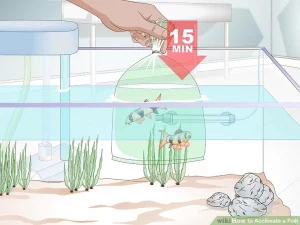

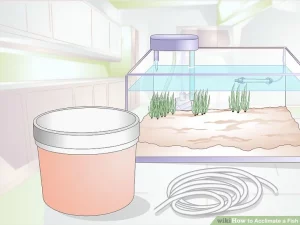

Temperate fish food
A commonly asked question from newcomers to keeping temperate fish centres around what to feed them. Most fish foods are listed as suitable for tropical or cold water varieties but don’t mention temperate species! In our experience, tropical fish food is best for temperate species. Tropical fish food tends to be formulated for more active fish with higher metabolisms and energy requirements.
In this regard, most temperate fish are much more similar to tropical species, meaning that tropical fish food is usually optimal. Good examples would be Tetra’s TetraMin Crisps, and—for smaller varieties of temperate fish—Tetra Micro Granules.
Pets at Home Love Fish Temperate Flakes
Some brands, like Love Fish from Pets at Home, now sell a dedicated temperate flake food. However, a closer look at the ingredients and analytical constituents shows that Pets at Home’s temperate flake is almost identical to its tropical flake! Furthermore, there’s virtually no difference between their temperate flakes and their cold water version, either.
Love Fish Coldwater Flakes
Ingredients/composition: Fish and fish derivatives, derivatives of vegetable origin, algae, oils and fats, molluscs and crustaceans.
Analytical constituents:
Protein 48.2%
Crude fibre 1.4%
Crude fat 10.5%
Crude ash 11.0%
Love Fish Temperate Flakes
Ingredients/composition: Fish and fish derivatives, derivatives of vegetable origin, algae, oils and fats, molluscs and crustaceans.
Analytical constituents:
Protein 49.0%
Crude fibre 1.7%
Crude fat 9.9%
Crude ash 11.4%
Love Fish Tropical Flakes
Ingredients/composition: Fish and fish derivatives, derivatives of vegetable origin, algae, oils and fats, molluscs and crustaceans.
Analytical constituents:
Protein 49.0%
Crude fibre 1.8%
Crude fat 10.9%
Crude ash 11.3%
As you can see, their ingredients are identical, and there’s only a 1% (or less!) difference in the protein, fibre, or fat levels of either of the three foods.
Rather than worrying too much about the difference between specific cold water, temperate, and tropical foods, it’s better to focus on the quality of the diet of your fish. For example, pick a couple of premium dry foods for variety and then feed a choice of frozen foods like bloodworm, glass worms, daphnia, brine shrimp, or cyclops a couple of times per week from a brand like TMC or Ocean Nutrition.
Frequently asked questions
How often should I feed temperate fish?
For temperate fish, we follow the same principles as feeding tropical varieties. With that, little and often is best. Ideally, provide a small amount of food 3-4 times per day – as much as your fish can eat in a couple of minutes.
Alternatively, one or two larger feeds should also suffice, adding as much food as can be eaten in 3-5 minutes. However you choose to feed your temperate fish, there shouldn’t be food left over once they’ve had a few minutes to eat. Exceptions apply for things like algae wafers, though, which may take some fish a few hours to finish completely.
Can I mix tropical and temperate fish?
Sort of. Temperate fish with broader optimum temperature requirements can generally be kept with compatible tropical fish in aquariums where the water is, for example, 24°C or 25°C. However, you’d be maintaining a tropical tank with some temperate fish at that point.
Because you cannot keep most tropical fish at temperatures of 23°C or below, they aren’t suitable for temperate tanks without heaters. So, while some species will happily mix under the right conditions, tropical fish cannot be kept in a temperate tank – so combining them in that regard is a no-no.
Can you keep goldfish with temperate fish?
While it’s possible to keep some temperate fish species with cold water and tropical varieties alike, they’re best suited to life among themselves at their own, more specific optimum temperature.
What’s more, goldfish, in particular, are big and greedy. With that, they’re not opposed to eating smaller temperate fish given half a chance. Some temperate fish are also prone to fin-nipping, making them unsuitable for life alongside fancy goldfish with long, flowing fins.
Are guppies temperate fish?
We prefer to keep our guppies (Poecilia reticulata) at temperatures above 20°C and preferably warmer still – in the region of 24°C. To us, that means they’re not a temperate species. However, plenty of people report success keeping them several degrees cooler – e.g., at 19-23°C. There are similar suggestions about Endler’s livebearers (Poecilia wingei), too.
Yet, Endler’s, in particular, are fish that we only ever keep in truly tropical tanks at a minimum of 24°C. So, when it comes to either guppies or Endler’s, we wouldn’t keep them in temperate conditions. That’s especially given the massive range of truly temperate fish that are known to be happy at lower temperatures.
A closer look at eight of our favourite temperate fish
Albino paradise fish (Macropodus opercularis var. ‘Albino’)
Macropodus opercularis (albino form below) is a classic aquarium species, first introduced to the western fishkeeping hobby over 150 years ago. This fact gives the species the distinction of being one of the very first ornamental fish imported to Europe. It’s also known as the Chinese fighting fish, paradise gourami, and blue paradise fish.
Wild-type examples are uncommon in the aquarium hobby, with the pretty albino, red, and blue varieties now much more common. There are also a number of other selectively-bred ornamental strains, including xanthic and stripeless forms.
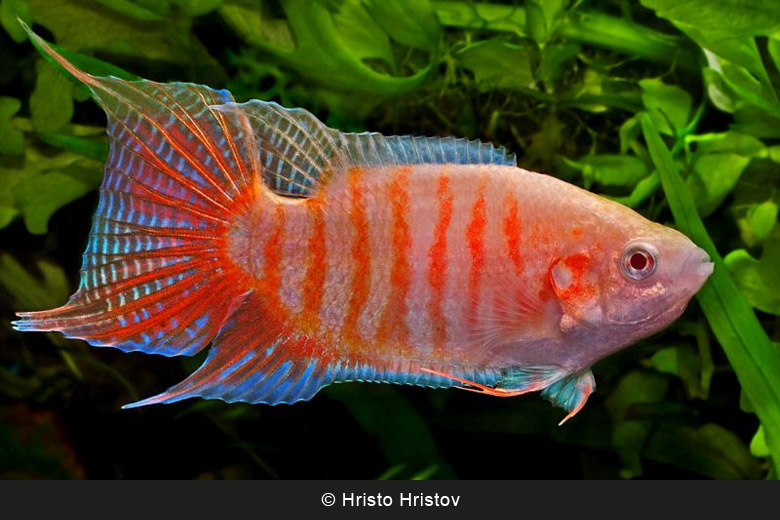

Black tiger badis (Dario sp. var. ‘Myanmar’)
The black tiger badis (above) is a relative newcomer to the fishkeeping hobby, first made available in 2005. Dario sp. var. ‘Myanmar’ is also commonly referred to as Dario sp. var. ‘Pyjamas’ or the fire red tiger badis.
Small but feisty, it’s a great candidate for temperate nano aquariums. Males are more colourful than females and can be aggressive toward each other. It’s therefore advisable to keep one male, either alone or with several females, in a species-only set-up or alongside suitable tankmates like smaller rasboras and loaches.
Empire gudgeon (Eleotris compressus)
Something of an oddball, Eleotris compressus (below) is an unusual addition to any aquarium. Best suited to harder, more alkaline water, in the wild, they live and breed between freshwater and saltwater. Also known as the Australian empire gudgeon, in an aquarium setting, they’re happy exclusively in freshwater, including under temperate conditions.
If your local tap water is soft and acidic, it’ll be necessary to buffer it. We use Seachem Alkaline Buffer, but you can achieve similar results by opting for a coral sand substrate or decorative rocks with a high limestone content.
Choose tankmates carefully, owing to their requirements for water with a pH north of seven. Green swordtails and various barb species would be good, for example. The colourful, temperate empire gudgeon may eat small fish, so avoid any tiny tankmates to be on the safe side.


Florida flagfish (Jordanella floridae)
Another interesting, if somewhat feisty, addition to a temperate aquarium is the handsome Florida flagfish (above). Highly adaptable, Jordanella floridae is happy in either a temperate or tropical tank. In the wild, they favour shallow, weedy habitats – including canals and ditches! Opt for neutral to slightly alkaline conditions in an aquarium setting with plenty of live plants.
Best when maintained as a group, a mixture of males and females will ensure a colourful and exciting display. Florida flagfish are compatible with similarly sized temperate and tropical species, ideally those from similar geographical habitats. Other North and Central American species, such as the rosy red minnow (Pimephales promelas), butterfly goodeid (Ameca splendens), and variatus platy (Xiphophorus variatus) are prime examples.
Glowlight danio (Celestichthys choprae)
In our opinion, the glowlight danio (below) is one of the prettiest fish routinely offered in the aquarium trade. Tiny at barely an inch fully grown, they’re a highly active species, so not ideally suited to nano aquariums, despite their small size. Plenty of flow and a dark substrate will show Celestichthys choprae off to its best.
Generally placid, aim for a group of at least six. Suitable tankmates are other similarly sized cyprinids, peaceful anabantoids, and small catfish or loaches. That’s particularly true of those hailing from in and around the glowlight danio’s native Myanmar.
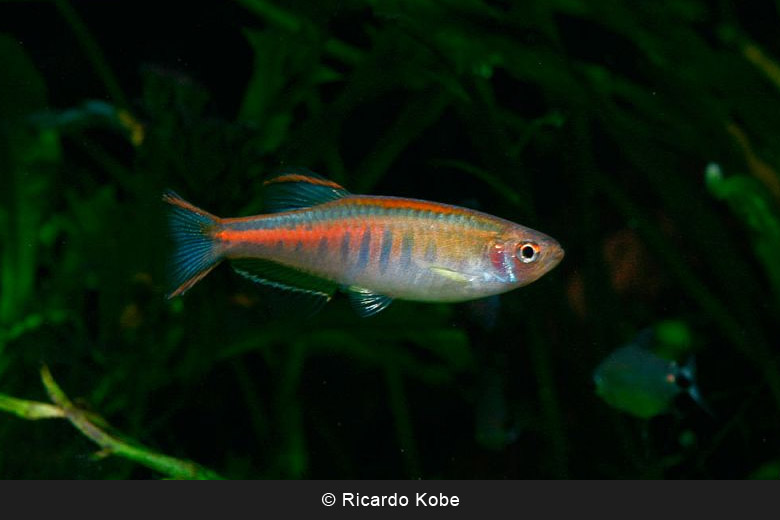

Rainbow shiner (Notropsis chrosomus)
Also known as the Alabama shiner, Notropsis chrosomus (above) comes from North America, where it’s well-adapted to a variety of conditions. Males, as pictured, are more colourful. They look their best in a group, where the male fish will colour up and show off to their female tankmates.
Great for unheated temperate tanks in colder houses, rainbow shiners aren’t phased by temperatures down to 10°C. That said, they’re happier and generally more active when kept at typical room temperatures closer to 20°C.
Sparkled orange ricefish (Oryzias latipes var. ‘Sparkled orange’)
A form of the standard Japanese ricefish, the sparkled orange variant (below) is by far our favourite. A pretty fish that’s best kept in groups, it’s also easy to breed. Interestingly, ricefish hold the accolade of being the first vertebrate animals to be bred in space.
In our aquariums, sparkled orange ricefish are happiest under temperate conditions. In fact, keeping them in warmer surroundings can reduce their lifespans. Aim for the lower end of the temperate range and they’re an undemanding fish that’s fun to watch, especially in more densely planted tanks.
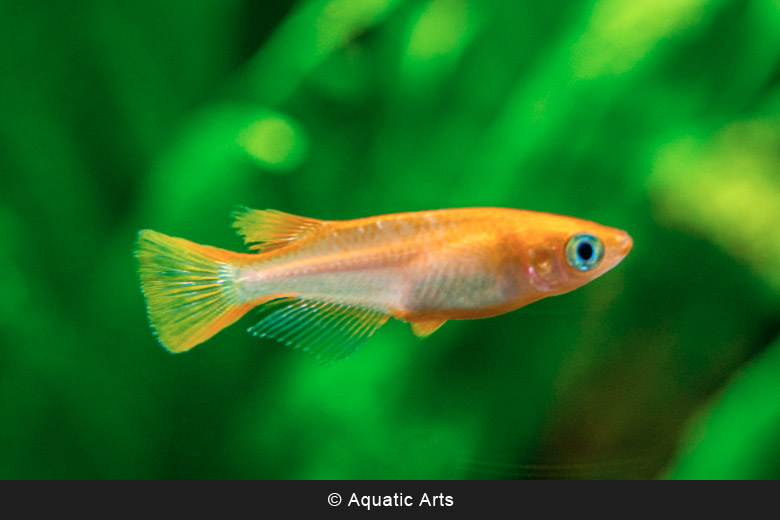

Neon red rosy barb (Pethia conchonius var. ‘Neon red’)
The regular rosy barb, Pethia conchonius, has long been a go-to species for temperate tanks. But, while pretty, it’s not a patch on the neon red variety (above) that’s our favourite. They’re a fish that has to be seen to be believed, as pictures tend not to do them justice.
They’re a sizeable fish, too, growing up to 15cm – six inches in old money. Happiest at 18-22°C, they’ll be fine at a degree or two warmer for a short period. In anything, though, they’d rather be cooler. We’ve kept larger, adult neon red rosy barbs outside during the warmer summer months, where overnight temperatures dip well below 18°C. In doing so, we’ve even been rewarded with hundreds of offspring!
A great addition to larger temperate tanks, just ensure that you avoid any tiny tankmates who are likely to be intimidated, especially by groups of multiple neon red rosy barbs. Our preferred tankmates include hoplo catfish, gold barbs, and green swordtails. Together with the metallic green colours of the latter, both fish look even better, in fact!
Temperate fish tank plants
One final thing to consider when it comes to keeping temperate fish is plants for their tank. Not all plants thrive under temperate conditions. Thankfully, most popular aquarium plant varieties do better at cooler temperatures than at warmer ones.
When buying plants, try to do so from a brand like Aquadip. All Dutch grower Aquadip’s potted plants come with helpful care information on their labels, including optimum temperatures. The same is true of Aquafleur, too. However, not all aquarium plant brands provide this information, including one of our favourites – Tropica.
Temperature is an essential piece of information, and, as much as we love Tropica, it remains something that’s sadly lacking from the Danish brand’s plant labels. Instead, they rely simply on Easy, Medium, and Advanced categories. In a temperate setting, sticking to Tropica plants labelled Easy is best, although some Medium plants may not be out of the question.

Something that may also require a little extra exploration is a given plant’s pH requirements or preference for harder or softer water. Some plants, like Vallisneria species, only really thrive in hard water. So, it would be suitable for a temperate tank containing empire gudgeons, for example. In softer water with species like Asian moth catfish, it’s likely to melt. However, more adaptable plants, or those actually preferring soft water, should thrive.
In any case, and purely temperature-wise, when maintaining a range of 18–23°C, some good plant choices are:
- Blue water hyssop (Bacopa carolina)
- Broadleaf arrowhead (Sagittaria latifolia)
- Chinese marsh ivy (Cardamine lyrata)
- Common pennywort (Hydrocotyle vulgaris)
- Creeping primrose-willow (Ludwigia repens)
- Dwarf hairgrass (Eleocharis parvula)
- Giant fanwort (Cabomba aquatica)
- Indian waterweed (Hygrophila polysperma)
- Large-flowered waterweed (Egeria densa)
- Pygmy chain sword (Echinodorus tenellus)
- Soft hornwort (Ceratophyllum submersum)
- Spade-leaf sword (Echinodorus cordifolius)
- Spiral vallis (Vallisneria spiralis)
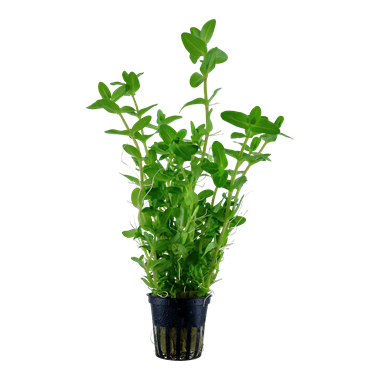
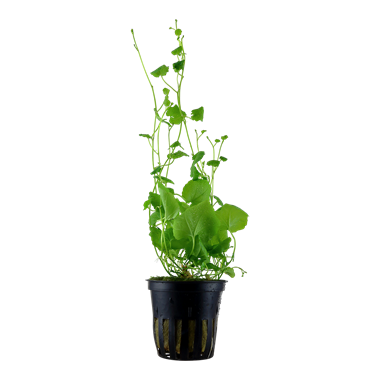

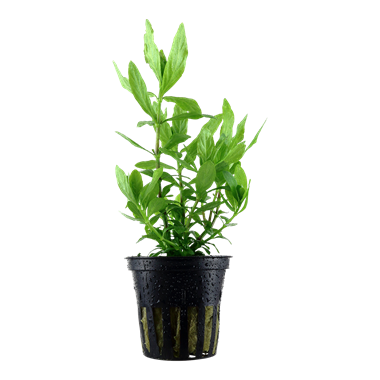

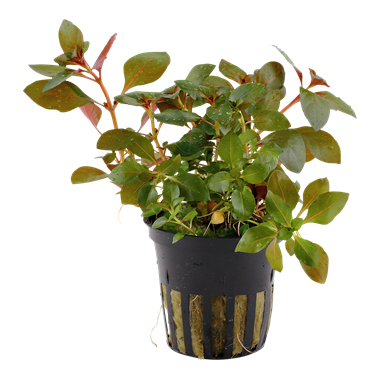
Like any plant—whether aquatic or terrestrial, tropical or temperate—light and food are essential for them to thrive. None of the above plants are overly demanding, so even basic lighting should suffice. Fish waste will also provide most of the nitrogen and phosphorous they need to grow. However, an additional aquarium plant fertilizer containing potassium and iron should really help them to take off, even at 18°C.

